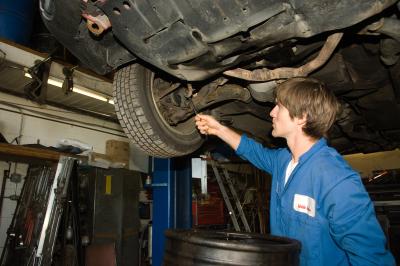
The Honda Odyssey, as with every Honda built, exceeds government standards for vehicle safety, including stopping distance. The performance of the Odyssey's brakes depends on the level of maintenance provided to the braking system. The first point of interest in maintaining the braking system is making sure the surface on the brake pads is sufficient to stop the vehicle within acceptable distances. Worn pads will not be able to handle the heat generated during braking and brake failure can occur.
Park the Honda in an area that provides a proper space and safety to change the brake pads. Seek a locations that is relatively flat, dry, away from passing traffic and away from a curb.
You will need a tire iron, a lifting jack, jack stands, a 13mm wrench, vise-grip pliers or a C-clamp, tire blocks and a flat screwdriver. The jack stands will provide a stable base from which to work. You may also need chain lubricant or some other lubricant such as WD-40 in the event the brakes are rusted.
Place the tire blocks behind the rear wheels to prevent the Odyssey from rolling. Put the transmission in "park" and apply the parking brake.
Start with the wheels pointed forward. Use the socket on the tire iron to loosen the lug nuts on the wheel. Place the lifting jack beneath the frame of the vehicle and lift the vehicle to insert the jack stands. Lower the vehicle onto the jack stands, leaving enough clearance between the tires and the road surface for removal and replacement of the wheels. Finish removing the lug nuts by hand and pull the wheel from the lug nut bolts.
The caliper is the apparatus that surrounds a portion of the rotor. On the side of the caliper facing away from you are the two caliper bolts. Turn the steering wheel of the Honda away from the wheel you are working on. When working on the front left brake, turn the wheel to the right. This will afford you the space needed to remove the caliper bolts.
Use a 13mm wrench to remove each of the caliper bolts. Once the bolts are removed, pull the caliper from its position surrounding the rotor. Inspect the rotor for scoring. If the brake pad wear indicators have been rubbing into the rotor surface, the damage could warrant rotor resurfacing or replacement.
The brake pads are housed on either side of the caliper. They are fixed to the caliper walls by way of thin metal clips. Slide the pad's clips from the caliper walls. If the brake pads are rusted, use chain lubricant to loosen the rust's grip. If the lubricant is ineffective, pry the clips away from the caliper using a flat screwdriver. Do not worry about damaging the clips as the new set of pads will have their own.
Once the pads have been removed, you will see the caliper piston protruding from the inside of the caliper wall. The piston is extended because it needed to be in the more forward position to keep the worn pad at a point ready to make contact with the rotor during braking. You will need to open the piston to accept the girth of the new pads.
Place a C-clamp or vise-grip pliers against the piston and the wall from which it extends. Squeeze the piston against the wall of the caliper until it is flush with the side. Place the new brake pads into position by sliding the metal clips on either wall of the caliper. When installed properly, the pads will face each other and the curve of the pads will match the curve of the caliper.
Return the caliper to the rotor and replace the caliper bolts, using the wrench. Turn the steering wheel so that the wheels are once again pointed forward. Put the wheels onto the lug nut bolts and replace the lug nuts by hand. Lift the vehicle to remove the jack stands and then return the Honda to the ground. Tighten the lug nuts with the tire iron.
Press the brake pedal repeatedly until the pedal response is normal. When you opened the caliper piston you forced brake fluid from the caliper. By pressing the pedal you are returning fluid to the caliper and placing the piston in the correct position to push the pads against the rotor to stop the vehicle.